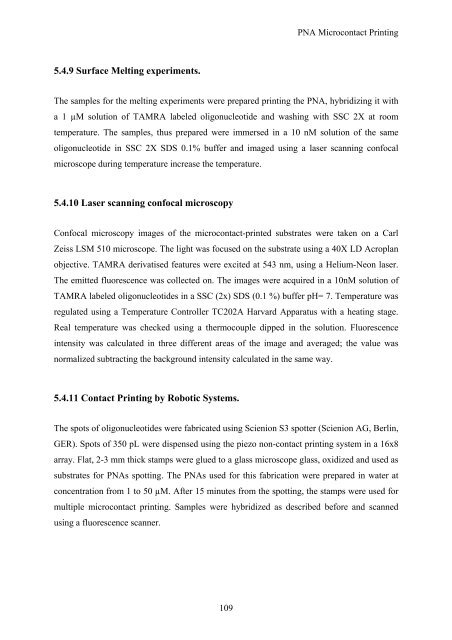View - DSpace UniPR
View - DSpace UniPR
View - DSpace UniPR
Create successful ePaper yourself
Turn your PDF publications into a flip-book with our unique Google optimized e-Paper software.
PNA Microcontact Printing<br />
5.4.9 Surface Melting experiments.<br />
The samples for the melting experiments were prepared printing the PNA, hybridizing it with<br />
a 1 µM solution of TAMRA labeled oligonucleotide and washing with SSC 2X at room<br />
temperature. The samples, thus prepared were immersed in a 10 nM solution of the same<br />
oligonucleotide in SSC 2X SDS 0.1% buffer and imaged using a laser scanning confocal<br />
microscope during temperature increase the temperature.<br />
5.4.10 Laser scanning confocal microscopy<br />
Confocal microscopy images of the microcontact-printed substrates were taken on a Carl<br />
Zeiss LSM 510 microscope. The light was focused on the substrate using a 40X LD Acroplan<br />
objective. TAMRA derivatised features were excited at 543 nm, using a Helium-Neon laser.<br />
The emitted fluorescence was collected on. The images were acquired in a 10nM solution of<br />
TAMRA labeled oligonucleotides in a SSC (2x) SDS (0.1 %) buffer pH= 7. Temperature was<br />
regulated using a Temperature Controller TC202A Harvard Apparatus with a heating stage.<br />
Real temperature was checked using a thermocouple dipped in the solution. Fluorescence<br />
intensity was calculated in three different areas of the image and averaged; the value was<br />
normalized subtracting the background intensity calculated in the same way.<br />
5.4.11 Contact Printing by Robotic Systems.<br />
The spots of oligonucleotides were fabricated using Scienion S3 spotter (Scienion AG, Berlin,<br />
GER). Spots of 350 pL were dispensed using the piezo non-contact printing system in a 16x8<br />
array. Flat, 2-3 mm thick stamps were glued to a glass microscope glass, oxidized and used as<br />
substrates for PNAs spotting. The PNAs used for this fabrication were prepared in water at<br />
concentration from 1 to 50 µM. After 15 minutes from the spotting, the stamps were used for<br />
multiple microcontact printing. Samples were hybridized as described before and scanned<br />
using a fluorescence scanner.<br />
109
















